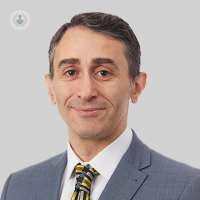Hand injuries: an in-depth and expert analysis
Autore:Top Doctors recently spoke to highly esteemed London and Elstree-based consultant trauma and orthopaedic surgeon, Mr Omar Haddo, who, in this informative article below, reveals what the most common hand injuries that he treats are, and explains in detail what a typical hand operation involves.

What are the most common hand injuries?
The most common hand injuries are either fractures or damage to tendons or ligaments. They are almost always related to some sort of fall.
What are some of the most severe hand injuries?
There are a handful of severe hand injuries. The main ones include the following:
- a severe fracture
- damage to the blood vessels of the hand
- an open fracture (where the skin is cut)
Can you detail what a typical hand surgery would entail?
The most common hand operation is a fixation of a fracture. The type of procedure really depends on where the fracture has occurred in the hand. We could carry out an open reduction (internal fixation), or a closed reduction which includes wiring to hold everything in place.
If you tear tendons, then this often involves a repair of the tendons. You have to open up, find the two ends and stitch them back together. If the tendon has been torn for quite some time, then it would be more suitable to reconstruct the tendon rather than directly repair it.
What are the most common sports-related hand injuries that you have treated?
The most common I have seen is when the bones in the palm of the hands are fractured, and I have seen many boxers damage their bones in the little finger. Punching in the wrong way can certainly be a cause of this.
Also, in relation to sport, I have seen plenty of fractures of the wrist. Whether it is a running sport or another kind of sport, tripping and falling on an outstretched hand can cause injury either to the forearm bones near the wrist, or the wrist bones themselves.
Is surgery always required to treat hand injuries?
No. Special types of splints can hold the damaged ligament or bone in place without the need for surgery in many scenarios. However, surgery is indeed required for things that we know are not going to heal naturally.
For example, we can’t just pull a displaced fracture that has moved out of place back into place unfortunately, and if we leave it, it will likely heal in the wrong position, so we have to get it back into place through surgical means. If you have a torn tendon, they are extremely unlikely to come back together, so surgery will be required here as well.
Mr Omar Haddo is an extremely well-regarded consultant trauma and orthopaedic surgeon who specialises in hand injuries and hand surgery. Contact him today and make an appointment with him via his Top Doctors profile.


